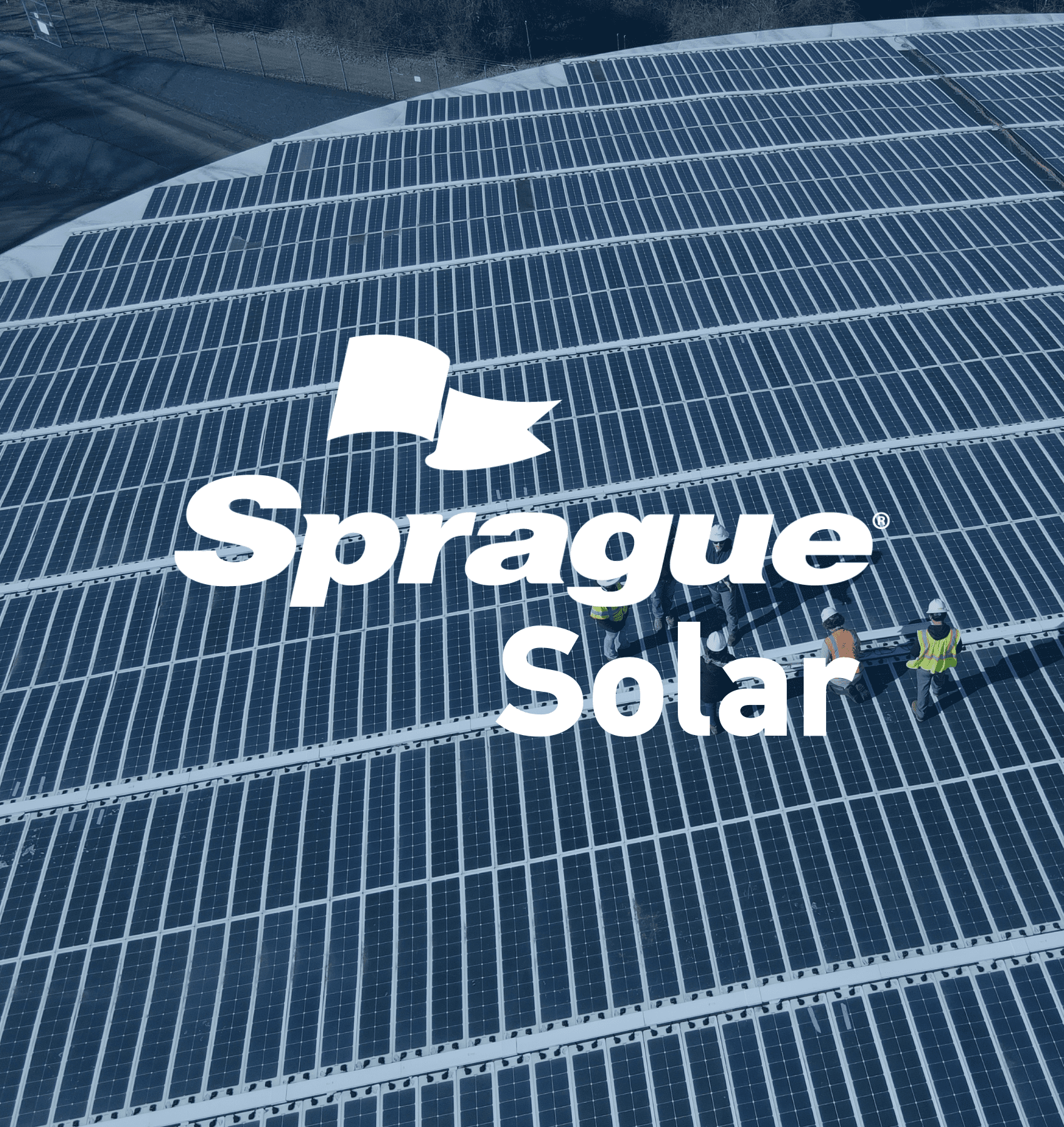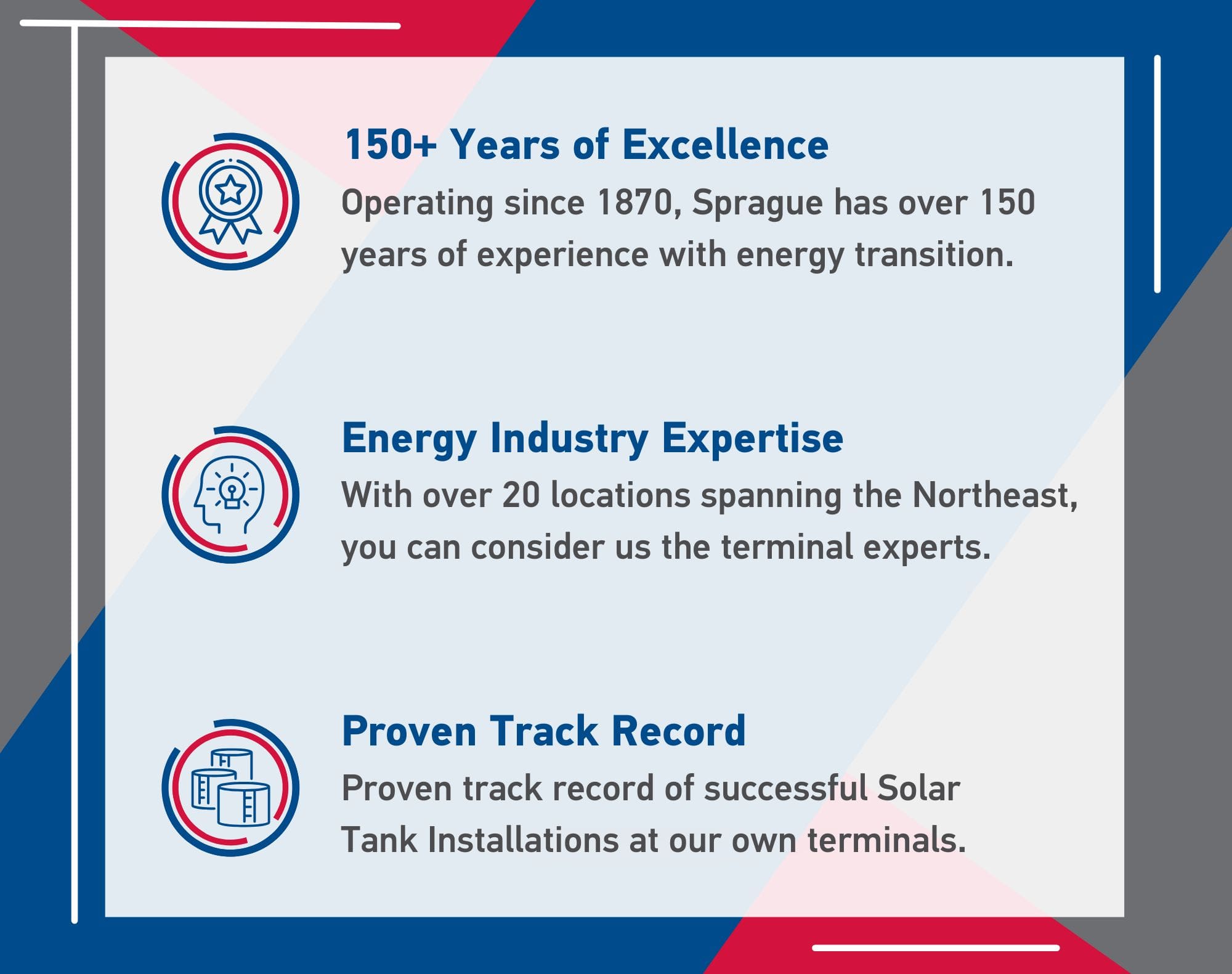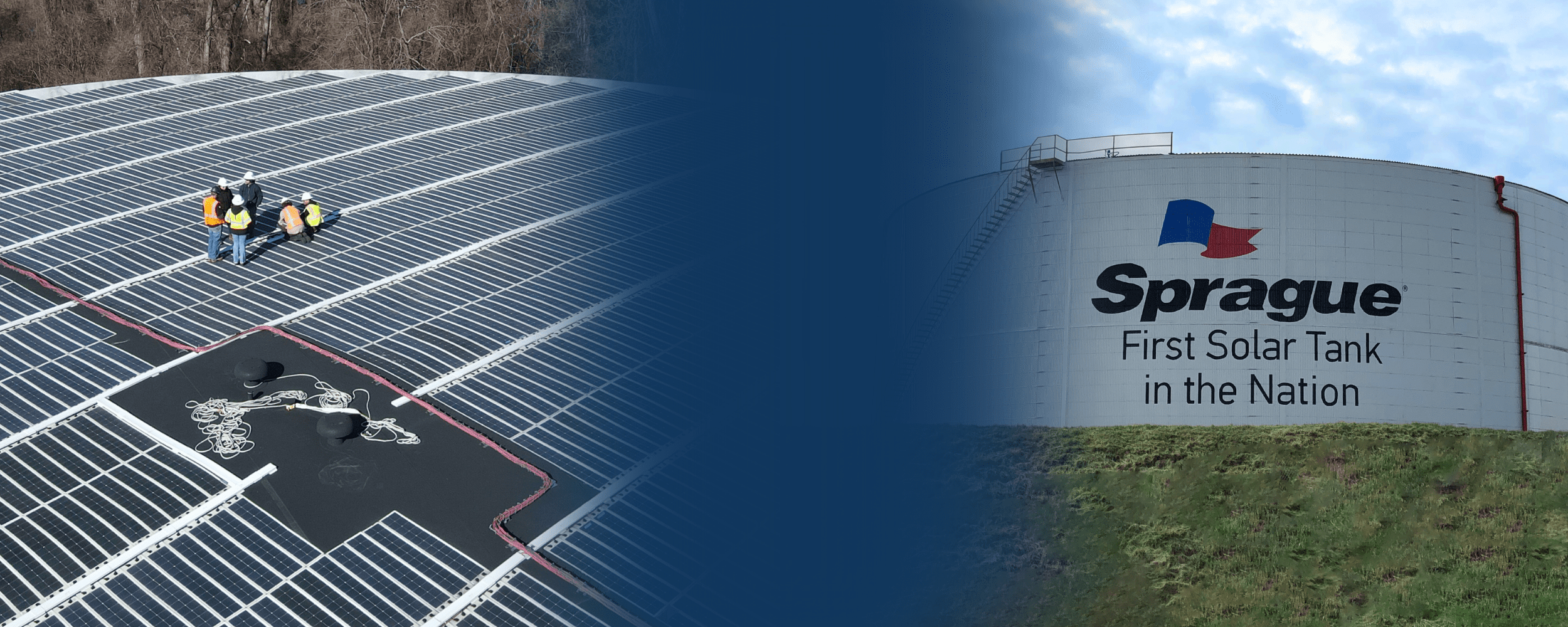
Sustainably Reduce Your Operating Costs
In 2017, Sprague led the way with the Nation’s first solar liquid storage tank top, proving that sustainability and efficiency can go hand in hand. Now, we’re helping businesses across the U.S. harness solar power to reduce costs, meet ESG goals, and enhance energy independence.
Our durable, flexible, thin-film solar panels are designed to seamlessly integrate with your petroleum storage tank tops without interrupting daily operations. Whether you're looking to cut energy expenses, stabilize pricing, or reduce your carbon footprint, Sprague Solar delivers turnkey solutions tailored to your needs.
Why Choose Solar for Your Tank Tops?
Click on the icons below to learn more!
Reduce or Normalize Onsite Load
Offset energy consumption by using solar power to stabilize and lower overall site demand.
Safely Leverage Unused Real Estate
Transform unused tank top space into a productive, energy-generating asset without impacting operations.
Reduced Tank Top Maintenance
Protect tank tops from weather exposure, reducing wear and tear over time.
Enhance On-Site Energy Resiliency
Maintain power reliability and reduce dependence on external energy sources with on-site solar generation.
Add Battery Storage for Future Demand Management
Store excess solar energy to optimize usage and reduce peak demand costs.
Why Choose Sprague Solar?
Reduced Operating Expenses
Sprague provides a turnkey solar solution with the potential for zero upfront costs and guaranteed OpEx reduction.
No Business Disruptions
Panels can be installed on your tanks without interrupting your daily operations, ensuring business continuity.
20-Year Warranty (85% Efficiency for 20 Years)
Thin solar panels typically come with a robust 20-year warranty, which speaks to their durability and long-term performance. This warranty often guarantees that the solar panels will maintain an efficiency of 85% or greater throughout the entire 20-year period.
Hurricane Rated to 175 mph
The hurricane rating of 175 mph signifies that these thin solar panels are designed to withstand extreme weather conditions, including hurricane-force winds. This level of resilience ensures that the solar panels remain operational even in the face of severe storms, minimizing the risk of damage and downtime.
Proven Success at Sprague Terminals
Pilot Programs
Since launching our initial pilot project in 2017 with the first-of-its-kind flexible solar panel installation on a storage tank in South Portland, Maine, we have continued to expand our solar footprint. The initiative has grown to include the Rensselaer facility in New York—the state's first application of solar tank technology.
- The Rensselaer system produced 215,000 kWh in 2024, with an estimated 440,000 kWh expected in 2025, contributing to a projected lifetime production of 8.8 million kWh over 20 years.
- This output helps reduce operating costs, offset non-renewable energy from the grid, and garner local support for further solar expansion.
Over the next 20 years, liquid storage tank solar installations across just a few locations could generate approximately 22 million kWh of clean energy—delivering a significant environmental impact.
We Know Terminals

News
The Sustainable Impact Award at the annual Global Tank Storage Awards was given to Sprague Operating Resources LLC “for innovative application of thin-film solar panels”.
Sprague Energy was presented with the Sustainable Impact Award for its work on thin film solar panels applied to an oil tank – Sprague’s South Portland Terminal is home to the (first of its kind) solar storage tank. It said this marks the first time that thin film solar panels have been applied directly to the roof of a former oil storage tank.
Frequently Asked Questions
Will installing thin solar panels on tanks cause any disruptions to tank operations?
No, operators can walk on them without any additional slip factor or glare created. The panels also help protect the paint on top, reducing maintenance costs.
How does the presence of solar panels on an oil tank affect the switching of products within the tank?
Our panels are designed and constructed to meet the NFPA Class 1 Division 2 standard, ensuring safe operation on all petroleum and gas storage tanks, regardless of product switching activities.
Are there any concerns about the solar panels being slippery on top of a tank and are there any potential trip factors?
No, the panels do not increase the slip factor of a standard painted tank. Other than the panels being laid flat, cable trays are installed away from the edge of the tank and along the interior pathways created by the panels, with wires enclosed by the cable trays, which are approximately 6” – 8” high.
Can the solar panels be easily inspected and pulled off for maintenance or other purposes?
Yes, inspections for any physical damage to the panels are conducted through visual observation. Operation of each specific panel can be electronically tested or conducted by heat mapping. The inverters are also set up with wireless capability to monitor the systems remotely. If a panel needs to be replaced, another panel can be installed directly on top of the old panel, or if necessary, the adhesive can be heated so the panel can be peeled back or completely removed.
Is there any existing power infrastructure on top of the tank that can be utilized in conjunction with the solar panels?
Conduit typically runs up the tanks' side to power lighting, alarm, and gauging systems. We can use existing supports along the side and top of the tanks to run the conduit for the solar panels.
What happens if it snows?
In snowy conditions, both typical tanks and solar tanks experience snow melting relatively quickly due to the roof's slope and the tank's warmth. Solar panels can still function through up to approximately 10 inches of snow, although at a reduced capacity. However, the heat generated by the panels often accelerates the snow's melting process.
Can they maintain their full capacity by working through 10 inches of snow?
No, they operate at a reduced capacity (depending on the consistency of the snow/ice) but become fully operational once the snow is melted.
Are there any concerns or operational issues related to snow accumulation on the panels?
No, other than large snowfalls and ice accumulation, the snow itself does not impact the operation of the panels or solar array.
What should be expected after 20 years using these panels?
After 20 years, you can expect the following:
- The warranty guarantees 85% efficiency (20 year warranty).
- The panels will continue to work, but there is no guarantee that they will operate at a capacity greater than 85%, although it's possible.
- The primary concern is the life expectancy of the inverters, which typically have a 7-year warranty.
- It's advisable to budget for two replacements within the 20-year period.
Will the panels continue to function after 20 years, or will they likely require replacement?
The panels will continue to function after 20 years, but the power output will be lower. The decision to replace them will depend on your future energy needs and associated costs.
How will we interconnect to the grid?
We will connect behind the meter for on-site consumption.
Associez-vous à Kildair
At Sprague, we understand the importance of finding energy strategies and services that fit your needs. Our experienced team offers deep insights and industry knowledge. Contact us today to see how we can make a difference for your business.
Contact Us:
Jin Jin Huang | Managing Director, Solar
jjhuang@spraguesolar.com
603.766.7409
Veuillez prendre note que pour le moment Kildair dessert uniquement les entreprises














